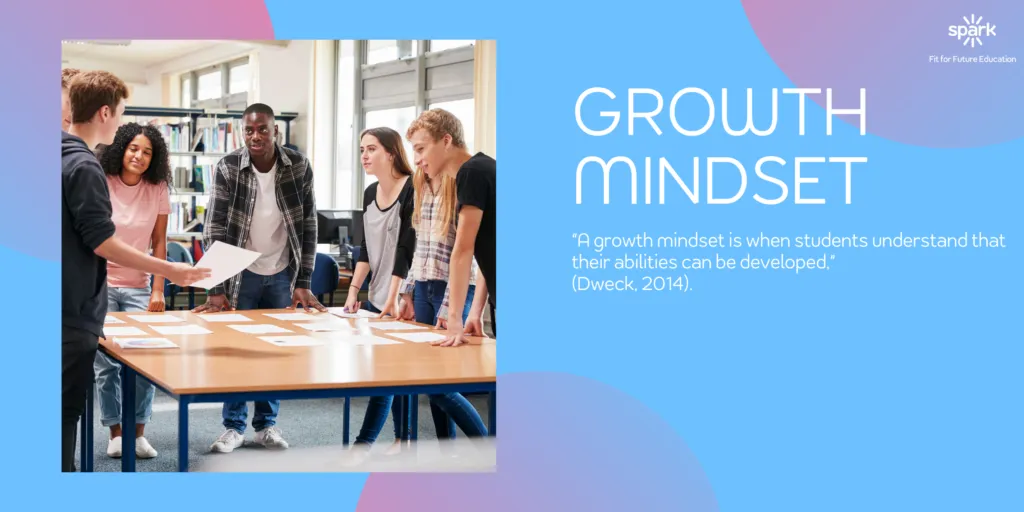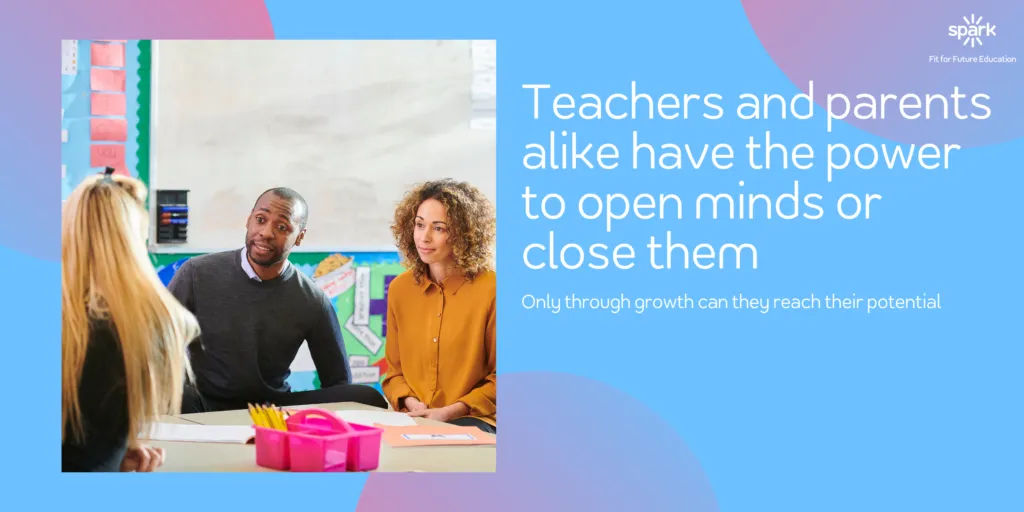“Fostering a growth mindset builds confidence, perseverance, and success in every student.” Dr. Carol Dwek, Standford University (The Joy and Power of Reading)
The actual socio-economic conditions, the family relationship, and the need for increased academic achievement put extra stress on the students. So to be able to help students have a growth mindset, teachers must at first help them cope with these stress factors. Starting with developing adequate skills to overcome these obstacles will prepare the ground for further growth.

Especially at the high school age, students face many changes and need to know they receive support in their development. Thus, an academic environment that teaches growth and where students are faced with challenges and put extra effort to succeed is what they need to grow.
The idea behind a growth mindset in education is known as grit. (Duckworth et al., 2007) Grit means the passion and perseverance someone pouts into succeeding on long–term goals.
Meaning
Every being has a mindset. The way we foster that mindset is the way we eventually feel – thus, we choose to have a positive mindset or a negative one, a growth one or a fixed one, and so on. There are big differences between them, and this is why school is a great place to teach students to have a growth mindset.

A growth mindset enables each student to grow and get away from the fixed perspective where they know they are good at something or not. A growth mindset teaches you to make efforts to become good in something you may not be. It is about engagement, motivation, and choice, and it is about knowing there are no limits to learning – only the ones we put to ourselves.
According to Ayers (2015, Encouraging a Growth Mindset), “a Growth Mindset is a collection of traits and dispositions that include a belief in the malleability of intelligence, intrinsic motivation, goal-oriented behavior, self – discipline, and others.”
While the primary goal of a school is to improve academic achievement for all children and help them learn, today, the goal widened, and assisting students to build the skills they need to be successful in life is just as important.
And as both teachers and parents, we must not build boundaries and limits to the children’s education ability. Teachers and parents alike have the power to open minds or close them – and we must open minds and show our students that only through growth can they reach their potential.
Differences between fixed mindset and growth mindset
A fixed mindset is one where students know that their skills and overall intelligence are fixed traits. Students with a fixed mindset believe that their talents and abilities are born and cannot be changed. It is characterized by resistance to learning new things and the belief they are incapable of improving. A fixed mindset is an answer to academic accomplishments limits. Without the eagerness to learn and develop, you cannot surpass your limits.
To have a growth mindset, students have to be in an environment that showcases them just this. We cannot take for granted that a growth mindset is something each student has – it has to be developed most of the time. A growth mindset is one where students know they can build their skills through perseverance and hard work, and they know that trying new things will help them learn more and improve their knowledge.
| Fixed mindset | Growth mindset |
| Accept what they know as a fact and stick to that point. | Realize that with hard work, their knowledge can improve, and this is what impacts the outcome. |
| Think that intelligence cannot be improved. | Try to identify areas where they can improve and do something about it. |
| Do not embrace challenges as they see them as signs of failure. | Embrace challenges and see them as motivating and educational. |
How to build a growth mindset in students
School is the central place where students can learn a growth mindset without being stressed about it.

Teachers can help students thrive and have a growth mindset through:
1. Acknowledging the importance of planning
It is important to praise intelligence and results and make sure it comes with acknowledging what drove the results – the planning and the effort. This will help them view the learning process differently and improve their knowledge. Providing students with more and more challenging work as they improve will help in their continuous growth.
2. Help them see what embracing challenges bring
More than just overcoming obstacles, taking on challenges will help students develop a growth mindset. Pushing them through their comfort zones, allowing them to see that new is good and complex concepts while asking for more.
3. Emphasize that sometimes learning takes time and effort – the power of “yet.”
Knowledge is taught, and with this in mind, help students fight the “I am not good at this.” and replace it with “I am not good at this yet.” Hard work and resilience are what each student needs to be good at what they want. Make sure to show students that each skilled person had to learn and put effort and determination to reach their goals. This will help students see that the innate ability has to be developed to reach its potential.
4. Learn from failing
Try to make sure students know that sometimes there may be failures at some point. However, they should not be a drawback but a push forward. Thus, this is a way to learn as much as possible. “Failing better” implies using the feedback to improve, staying motivated after the failure and trying again, seeing what you can do differently next time, and seeing that each task is about improving yourself and not proving yourself.
5. Let go of “I can’t” and embrace the “I can”
Thinking that you cannot do something will not allow you to try and see whether you can do it. Sometimes, there are moments when students remain surprised about something they can do and do not even know they can do it. Help students not get tempted to rush to “I can’t.”
Why is a growth mindset necessary?
A growth mindset fosters the healthy development of students’ needs.
It helps them to:
- Cultivate their talents
- Improve their abilities
- Learn new things
- Take on challenges with an open mind
- Have a positive attitude in life
- Increases well being and emotional functioning
Growth mindset at Spark Hybrid High School
Teachers play a significant role in creating an environment for growth mindset development. Here, at Spark School, we help students by providing guidance and continuous feedback and support in their learning journey. While challenging them and showing them to take responsibility for their actions, we also teach them that we are all different, that in our path, we make mistakes and have difficult moments, but we learn from them and move on.
What is a Growth Mindset? It is a disposition that embraces challenge, seeks out feedback and values effort as the pathway to mastery. Global Education Director – Iulia Bratfalean – Igna and our Head of School – Paul Kennedy shared some insights on how Spark School implements and sees a growth mindset for its students.

Students with a growth mindset enthusiastically take on the challenges given to them. They believe effort and perseverance are the criteria for achieving success. The learning journey is more important to them than arriving at the correct answer. Feedback is not perceived as a judgement of their ability and is put to good use because they understand that ability can grow. Students with a growth mindset are more likely to be inspired by the success of others.
This is how our students learn.
Each academic course is designed
- to engage the learner in challenging journeys while learning for each topic,
- to develop perseverance and resilience while putting effort in practicing to consolidate skills,
- to build confidence and growth through mastering activities.
The built in knowledge checks each of our learning courses have, are the best way for tutors to track the learning and give constantly formative feed-back.
We believe that everyone can learn at high levels in an environment filled with wonder and curiosity, we support communication and connections in learning and we value mistakes.
We teach our students that the brain activity is significantly higher if we have a growth mindset, if we believe in our unlimited potential of learning. Our cognition and what we learn is linked to our beliefs and to our feelings.
Conclusion
A growth mindset provides long-term benefits for students. Making sure the school and the parents sustain this mindset is a must. When we model a growth mindset by showing students we face challenges, we are persistent in this, and we are there, they realize they have an ally on this journey.
“Academic self–efficacy is the belief and confidence that students have about their capacity to accomplish meaningful tasks and produce the desired result in an academic setting.” Dr. William Brozo & Dr. E Sutton Flynn, Professors of literacy education (The Joy and Power of Reading)
Being challenged, encouraged, energized and supported, students will find their growth mindset. It is an essential skill that will help them throughout their life.




